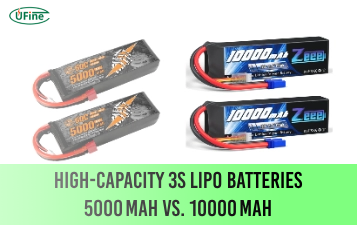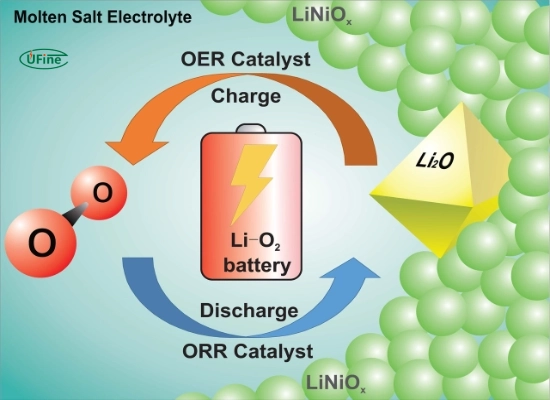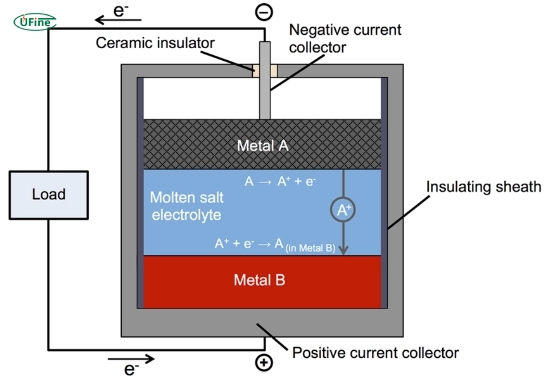A molten salt battery is a special high-temperature battery that uses liquid salts as electrolytes. Unlike regular batteries, which often use liquid or solid electrolytes, molten salt batteries require heat. This unique design gives them several advantages, such as high energy efficiency, long lifespan, and low cost.
These batteries have been around for decades but are now gaining more attention, especially with the growing demand for cleaner energy solutions. They are already used in fields like grid energy storage, military applications, and space missions.
This guide will explore everything you need to know about molten salt batteries, how they work, what makes them unique, their advantages, challenges, and future potential.
Let’s get started!
Part 1. What is a molten salt battery?
A molten salt battery is a rechargeable battery that uses liquid salts as electrolytes. These salts are solid at room temperature but turn liquid when heated. This liquid electrolyte allows ions to move freely between the battery’s electrodes, enabling the battery to store and release energy efficiently.
Key characteristics of molten salt batteries:
- Operate at high temperatures (typically between 200°C and 600°C).
- Use cheap and abundant materials, making them cost-effective.
- They have a long lifespan because they suffer less degradation than lithium-ion batteries.
- They can store large amounts of energy, making them ideal for renewable energy storage.
Molten salt batteries are not like your typical AA battery or lithium-ion battery. They require heat to work, which makes them suitable for specific applications rather than everyday consumer electronics.
Part 2. Key components of a molten salt battery
A molten salt battery is made up of four main components:
- Anode (Negative Electrode)
The anode is where oxidation occurs, meaning it releases electrons during discharge. The anode is made of sodium or magnesium in many molten salt batteries. - Cathode (Positive Electrode)
The cathode is where reduction happens, meaning it gains electrons during discharge. Common cathode materials include nickel or iron compounds. - Molten Salt Electrolyte
This is the most essential part of the battery. The electrolyte is usually made from sodium chloride, potassium chloride, or lithium chloride salts. These salts remain solid at room temperature but become liquid when heated. - Separator
The separator prevents direct contact between the anode and cathode, allowing ions to move through the electrolyte.
Part 3. How does a molten salt battery work?
A molten salt battery uses liquid salts as an electrolyte to allow ions to move between the battery’s positive and negative electrodes.
Step-by-step process of how it works:
- Heating the battery: Before it can work, it must be heated to a high temperature (often above 200°C). This melts the salt, turning it into a liquid electrolyte.
- Charging the battery: When charged, electrons move from the positive electrode (cathode) to the negative electrode (anode), storing energy.
- Energy storage: The liquid salt electrolyte allows ions to move freely, which helps store energy efficiently.
- Discharging the battery: When power is needed, the stored energy is released, and electrons flow from the anode back to the cathode, generating electricity.
Because these batteries need high temperatures to function, they are usually built with insulation to keep the heat inside and maintain efficiency.
Part 4. What makes molten salt batteries different from other batteries?
Molten salt batteries are very different from traditional lithium-ion or lead-acid batteries. Here’s why:
- They operate at high temperatures
Most batteries work at room temperature, but molten salt must be heated to 200°C or more. This high temperature helps keep the salt liquid, allowing for efficient ion movement. - They use liquid salts instead of liquid electrolytes
Many standard batteries use liquid or gel electrolytes. Still, molten salt batteries use a completely different type of liquid electrolyte—molten salt. This makes them more stable and less prone to leaks. - They last longer than lithium-ion batteries
Lithium-ion batteries degrade over time because of chemical reactions inside the battery. Molten salt batteries, however, are more resistant to degradation, meaning they can last decades with proper maintenance. - They are safer than lithium-ion batteries
One of the most significant risks with lithium-ion batteries is thermal runaway, where the battery overheats and catches fire. On the other hand, Molten salt batteries are much more stable under extreme conditions and do not pose the same fire risk.
Artikel Terkait: Molten Salt Battery vs. Lithium-ion: Comparing Performance, Safety, and Efficiency
Part 5. Advantages of molten salt batteries
Molten salt batteries have many advantages over other types of batteries.
- Cost-effective
These batteries use cheap and abundant materials, making them more affordable to produce than lithium-ion batteries. - Long lifespan
Molten salt batteries can last decades, whereas lithium-ion batteries start losing capacity after a few years. - High energy efficiency
They have low internal resistance, so they can store and release energy efficiently. - High thermal stability
Unlike lithium-ion batteries, molten salt batteries are not prone to overheating or catching fire. - Environmentally friendly
They do not rely on rare or toxic materials, making them a greener alternative to many battery technologies.
Part 6. Challenges of molten salt batteries
Despite their benefits, molten salt batteries have some drawbacks.
- High operating temperature
Since they need 200°C or more to function, they require a constant heat source, which can be challenging. - Insulation requirements
Sound insulation is needed to keep the battery hot, which can increase costs and complexity. - Limited applications
Because of their high-temperature requirement, they are not suitable for small-scale devices like smartphones or laptops.
Part 7. Applications of molten salt batteries
Molten salt batteries are used in various industries where high energy storage and durability are needed.
- Renewable energy storage: They store energy from solar and wind farms for grid stabilization.
- Military and aerospace: Used in missiles, satellites, and space missions because of their high reliability.
- Industrial backup power: Provides backup energy for factories and critical infrastructure.
Part 8. FAQs about molten salt batteries
Are molten salt batteries safe?
Yes! They are much safer than lithium-ion batteries because they do not overheat or explode.
How long do molten salt batteries last?
They can last decades, much longer than lithium-ion batteries.
Are molten salt batteries better than lithium-ion?
For large-scale energy storage, yes. But for portable electronics, lithium-ion is still better.
Can molten salt batteries be used in electric vehicles?
Not yet. Their high operating temperature makes them unsuitable for cars right now.
Why aren’t molten salt batteries widely used?
They need high temperatures to work, which makes them difficult to use in everyday applications.
Related Tags:
More Articles

High‑Capacity 3S LiPo Batteries: 5000 mAh vs. 10000 mAh
Compare 3S LiPo 5000mAh vs 10000mAh batteries by weight, power, and use. Find the best fit for your drone, RC car, or boat setup.
Top 5 Applications for Small 3S LiPo Batteries
Small 3S LiPo batteries power drones, RC gear, wearables, and robotics with high energy and low weight. Making them ideal for compact electronics projects.
Building and Charging Your Own 3S LiPo Pack: A Step‑by‑Step Guide
Learn how to build, balance, and charge a 3S LiPo battery pack safely at home with this complete DIY guide for hobbyists and beginners.
How to Choose the Right LiPo Battery Plug Type?
Discover the best LiPo battery plug types, how to choose them, and expert tips for safe usage, soldering, and maintenance.
Choosing the Right Connector for Your 3S LiPo Battery
Choosing the right 3S LiPo connector depends on current, space, and use. Learn the pros and cons of XT60, JST, EC3, and more.





